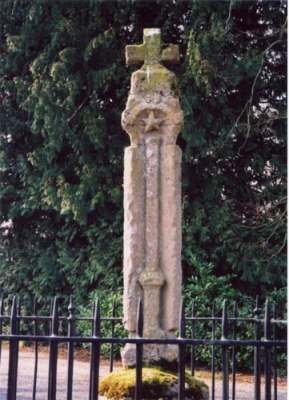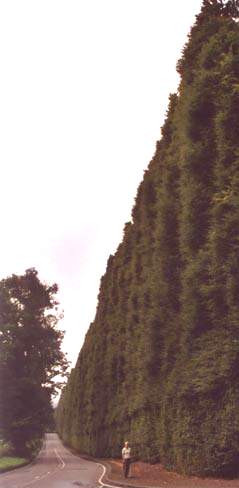


| [ Previous ] [ Next ] |

|
 Meikleour |
I enjoyed finding this snippet of lore, because it takes place in the later part of Tarleton's life, after he had retired from politics and left London. No timeframe is given, but the fact that it is set in the village of Meikleour, in Scotland, suggests 1817-1818, when Sir Banastre and Lady Tarleton spent "a season of hunting and fishing" in that country. The village of Meikleour is situated near the River Tay on A984 just west of the stretch of Highway A93 which runs north from Perth to Blairgowrie.1
The story appeared in 1903, as part of a biographical sketch of a colorful Meikleour personality named Stewart Jack (1787 - 1863). Stewart was a slater by profession but found his place in local tradition as a village philosopher. It presumably passed through 2-3 generations of oral retelling before it saw print, but its information meshes on numerous points with what is recorded about Tarleton's life.
A remarkable old soldier -- Sir Bannister [sic] Tarleton -- took Meikleour House for a number of seasons. He had been a captain of horse during the American War of Independence, and being of a bluff, hearty, good-natured disposition, and very fond of the villagers, he soon discovered A Brother Spirit in Stewart, who became a frequent visitor at the house, where over many a steaming bowl the old warrior
 The Cross |
Fought all his battles o'er again,
And thrice he routed all his foes,
And thrice he slew the slain.
The Meikleour slater, if he was not "fellow with the best king" was the "best king of good fellows" on such occasions. Old Tarleton used to maintain that after the war he was "played out like a d----d fighting cock!" He was a devoted angler, and the Tay close by yielded frequent tribute to his skill. His wife, however, who was equally kind-hearted and interested in the villagers, prevailed upon him to lay aside his takes on the Wednesdays for their behoof; but when he had landed a particularly fine fish on that day and wished to gratify some of his friends (and do a little self-glorification) he would compound with his humble and complaisant beneficiaries for a gift of flesh instead of fish -- always to the advantage of the recipients. Before leaving Meikleour for good and all he rode round the Cross on his war horse -- which he always brought with him -- three times, bidding goodbye to everybody, and as a final and inclusive valediction sat upright in the saddle, and thus addressed them:-- "My friends, I bid you all good-bye once more. I've been all round the world in my time, but swear I have never seen any dem'd place it has cost me so much trouble to leave as Meikleour!"2

| The tale was unearthed by Alex Crichton, who lives near Meikleour. He provided the additional information that the Cross, which dates from 1698, is still standing, and that "Meikleour House, dating from 1734 was reconstructed by Victorian architect David Bryce around 1870 for the Dowager Marchioness of Landsdowne, daughter of the Comte de Flahault. Bordering the grounds as well as the Perth to Blairgowrie road is the renowned Meikleour Beech Hedge planted in the autumn of 1745 by Jean Mercer of Meikleour and her husband Robert Murray Nairne. At an average height of 100 feet over a distance of just under 600 yards it is now the tallest in the world." |
[Thanks to Carolyn Jack for permission to reprint the quotation from the Jack family website, which has Stewart's full bio sketch posted [see links], to Alex Crichton who originally located the sketch as well as providing the photos, and to Linden Salter for bringing it to my attention.]
| [ Index ] | [ Previous ] [ Next ] |
1 The name of the village is pronounced "Ma-clure." Robert D. Bass, The Green Dragoon; The Lives of Banastre Tarleton and Mary Robinson (New York: Henry Holt and Company; 1957), p449. [ back ]
2 Henry Dryerre, Blairgowrie, Stormont & Strathmore Worthies, (Privately printed in Blairgowrie, 1903), pp131-144. [ back ]
| Return to the Main Page | Last updated by the Webmaster on October 31, 2004 |